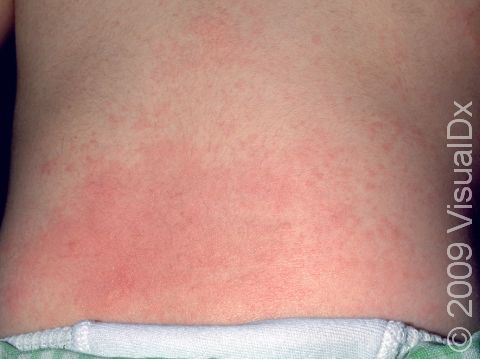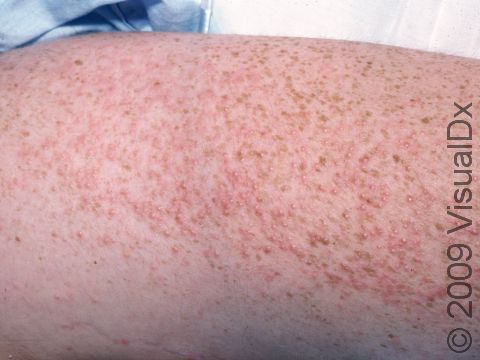Heat Rash or Prickly Heat (Miliaria Rubra)
Heat rash (miliaria rubra), also known as prickly heat, is a rash of small, red bumps caused by blockage of the sweat glands. It can be due to high fever, excessive sweating, or being over-bundled. Heat rash is commonly seen in hot, humid tropical climates. It can cause discomfort, itching, and, sometimes, stinging or “prickly”-type pain.
Who's At Risk?
Heat rash is seen in individuals who have a fever or those who have recently moved to a hot, humid climate. As many as 30% of those who move to a tropical environment experience this condition. Heat rash can be due to high fever, excessive sweating, or being over-bundled. It occurs in individuals of all races, although to a lesser degree in Asians.
Signs & Symptoms
Heat rash can occur after exposure to hot conditions. There can be many small, red bumps all over the body, usually occurring in highest concentration in covered areas where there is a lot of friction, such as the neck, chest, and body folds. The face, palms, and soles are generally not affected. Heat rash can cause intense itching and stinging, which can become worsened by heat. Your child may feel fatigued and become irritable and intolerant of heat, due to little or no sweating at the affected areas.
Self-Care Guidelines
Prevention and treatment of heat rash consist of controlling heat and humidity. Acetaminophen or ibuprofen can help to reduce fever. Remove any occlusive clothing, limit activity, and seek air conditioning or any cooler environment. Cool compresses can also help with the discomfort of heat rash. Make sure your child is drinking lots of fluids.
Treatments
If there are signs of bacterial skin infection related to the heat rash or otherwise, oral or topical antibiotics may be given.
Dehydration may be treated with intravenous fluids, especially if there is vomiting. Heat stroke is treated by trying to quickly reduce the core temperature to normal. Immersion, evaporative, or invasive cooling techniques may be used in addition to rapidly giving intravenous fluids.
Visit Urgency
The most common complications of heat rash include secondary infection from scratching and heat exhaustion.
Call your child’s doctor if he/she is scratching significantly. There are medications that can help with the itching and, thus, help prevent infection. Infected areas may need antibiotics. Call your child’s doctor if the area develops pus, redness, crusting, swelling, or tenderness.
In cases of heat exhaustion, the skin will appear hot and flushed without any sweat. Your child may complain of dizziness, nausea, weakness, headache, confusion, or difficulty breathing. This can progress to heat stroke, so medical care should be obtained right away. Symptoms of heat stroke include a very high temperature of 105°F or greater, decreased or loss of consciousness, or seizure.
While awaiting medical care, get your child indoors or under shade, undress the child, and apply cool compresses to the body or douse with cool water. Do not give fluids.
Trusted Links
References
Bolognia, Jean L., ed. Dermatology, pp. 510, 578-579. New York: Mosby, 2003.
Wolff, Klaus, ed. Fitzpatrick’s Dermatology in General Medicine. 7th ed., p. 730. New York: McGraw-Hill, 2008.
Last modified on August 16th, 2022 at 2:45 pm

Not sure what to look for?
Try our new Rash and Skin Condition Finder


